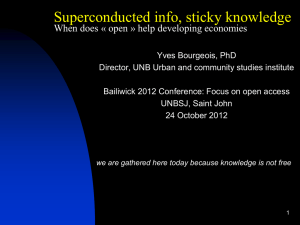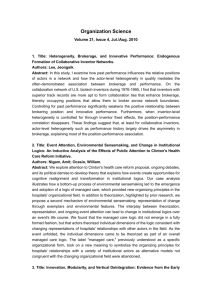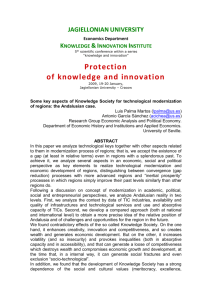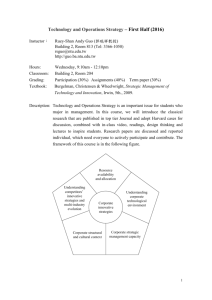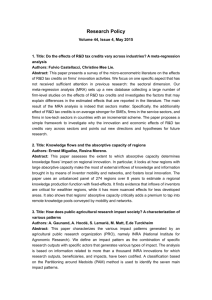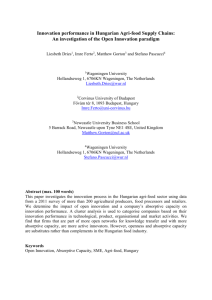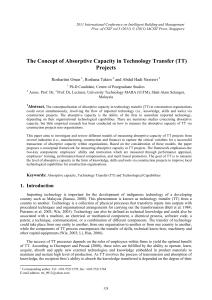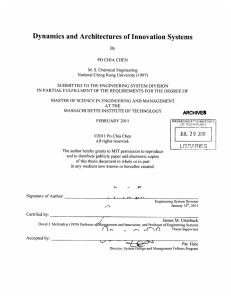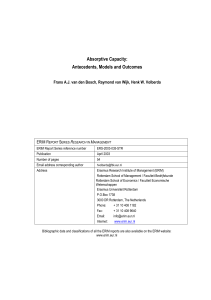Slides
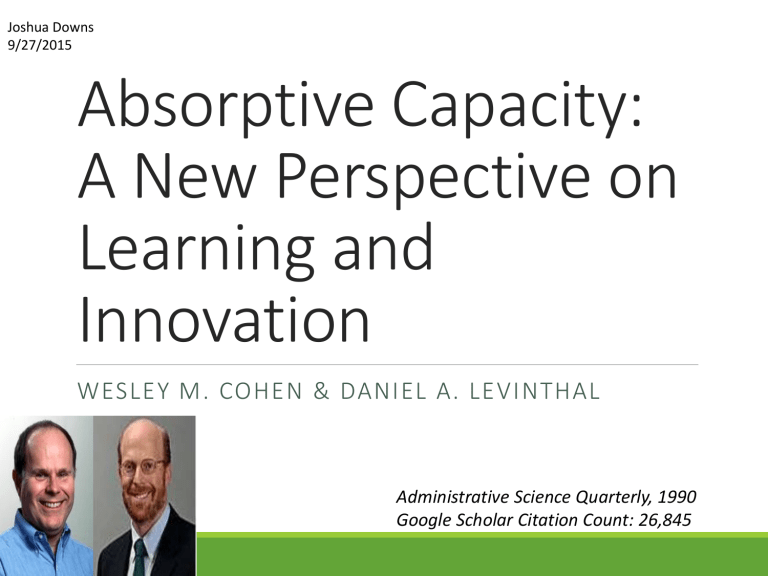
Joshua Downs
9/27/2015
Absorptive Capacity:
A New Perspective on
Learning and
Innovation
WESLEY M. COHEN & DANIEL A. LEVINTHAL
Administrative Science Quarterly, 1990
Google Scholar Citation Count: 26,845
Individual Cognitive Structures and Learning
Knowledge developed internally and acquired externally
◦ Level of prior related knowledge
◦ Knowledge can be nominally acquired, but not well utilized without contextual understanding
◦ Makes possible creative associations and linkages
◦ “Insights” leading to rapid problem solving
◦ Requires less new learning to attain a given performance level
◦ Intensity of efforts in developing related knowledge
◦ Increased usage of necessary associations improves retrieval of relevant knowledge
◦ Practice on early problems improves performance on higher complexity tasks later on
◦ Diversity of knowledge
◦ Increases likelihood of relatedness to novel problems
◦ Enables novel associations and linkages
From Individual to Organizational
Absorptive Capacity
Absorptive capacity of the organization depends on the absorptive capacity of individual members, developed cumulatively through persistent investment over time
◦ NOT a sum, but dependent on individuals at interfaces between entry points and subunits
◦ Structure of communication between external environment and internal organization including distal organizational subunits
◦ Character and distribution of expertise within organization as “gatekeepers” and “boundary-spanners”
◦ Outward vs Inward-looking absorptive capacities
◦ Tradeoffs in efficient internal communication and ability to assimilate knowledge originated externally
◦ Knowledge diversity vs knowledge overlaps
◦ Critical knowledge includes awareness of where useful complementary expertise resides within and outside the organization
◦ Focus on production improvement undermines development of absorptive capacity
◦ “Cross-function” absorptive capacities
◦ Linkages between R&D, design, manufacturing and marketing functions within the organization
◦ Necessitates redundancies as overlaps, requires depth AND breadth of knowledge for effectiveness
◦ Acquired absorptive capacity
◦ Limited with respect to firm-specific characteristics, integration with other firm activities
Path Dependence and
Absorptive Capacity
2 key features of absorptive capacity:
◦ Cumulativeness
◦ Accumulating absorptive capacity in one period will permit its more efficient accumulation in the next
◦ Expectation formation effects
◦ The possession of related expertise will permit the firm to better understand and therefore evaluate the import of intermediate technological advances providing signals about the merit of new technological developments
◦ More accurate predictions of the nature and commercial potential of tech advances
◦ Lack of development in initial periods can lead to “Lockout”
◦ Effects subsequent investment decisions through failure to appreciate opportunities
◦ Increases costs to develop to given level in subsequent periods, reducing investment incentive even when opportunity appreciated
◦ Organizations tend to focus on development within particular technological domain, “Not-Invented-
Here” Syndrome
◦ Practical production focus undermines Absorptive Capacity Development
◦ Organization’s aspiration: innovation in response to failure to reach goal (March &
Simon, 1958)
◦ Departs from model by including variance in terms of opportunity proactivity vs performance reactivity according to absorptive capacity, compounding neglect of technical opportunities through self-reinforcing cycle
Operationalizing Absorptive
Capacity: R&D Investment and
Determinants
Firm R&D activity: Generation of new knowledge and development of absorptive capacity
◦ Factors incentivizing learning by firms should influence R&D spending; incentives to learn influenced through quantity of knowledge to be assimilated and exploited & difficulty (knowledge complexity & complementarity) of learning
◦ Difficulty affected by objective complexity of knowledge and subjective complementarity to firm’s characteristics
◦ Further incentives include cumulativeness of technical knowledge base and pace of advance
◦ Determinants of R&D:
◦ Demand: Level of sales & price elasticity of demand
◦ Appropriability: Degree to which value of innovative activity is internally captured vs spilled over into public domain
◦ Technological Opportunity Conditions: 2 dimensions of cost of achieving normalized unit of technical advance in given industry
◦ Quantity of extra-industry technological knowledge complementing and leveraging knowledge output of the firm
◦ Degree to which unit of new knowledge improves technological performance of firm’s manufacturing processes or products, thus profits
◦ Interdependence with respect to impact of rival firm technical advancements on focal firm profit diminishment
Theoretical Models
Absorptive Capacity and R&D
Incentives
Absorptive Capacity and
Sources of Firm Technical Knowledge
Data and Measures
Data: Cross-sectional survey from American manufacturing sector by Levin et al.
(1983,1987) and FTC’s Line of Business Program data on business unit sales, transfers, and R&D; 1975-1977
Sample: 1,719 Business units representing 318 firms in 151 lines of business
DV: R&D Intensity: R&D expenditures as a percentage of business unit sales & transfers
IVs:
◦ Technological Opportunity: Relative quantity of useful knowledge index
◦ Relevance of basic & applied field base of science for industry & extra-industry knowledge sources
◦ Intra-industry Spillovers: Competitive advantage protection strength; APPROPRIABILITY
◦ Ease of Learning: Assumption that learning is less difficult for applied vs basic science relevant industries
◦ Interdependence: Four-firm concentration ratio & industry-level estimates of price elasticity of demand
Models: OLS, GLS adjusting for heteroscedasticity, and Tobit for observations with 0
R&D
Results
Takeaways
Knowledge as value-producing resource
◦ Prior related knowledge confers an ability to recognize the value of new information, assimilate it, and apply it to commercial ends
Learning is cumulative & performance is greatest when the object of learning is related to what is already known
◦ Explains investments in basic research even in preponderance of spillovers
◦ Novelty increases difficulty in learning
◦ Absorptive capacity can only be appropriately valued if it is already being developed
Absorptive capacity is not resident in any individual but depends on links across mosaic of individual capabilities
◦ Congruent with organizational capabilities (Nelson & Winter, 1982)
Interruption of absorptive capacity investment can result in technological “lockout”
Focus on production vs product improvement undermines development of absorptive capacity
Ease of Learning and resulting adoption of technology is affected by degree of relation to pre-existing knowledge
Discussion
What other human-centric, micro-level concepts are/can be extended to the macro-organizational level?
Drawing back on the property rights literature, this paper theorizes an external monitoring role within the organization that identifies valuable knowledge and communicates it into the firm. Should specialized monitors of the external environment receive some form of residuals as an effective means of reducing shirking incentives?
Does the paper sufficiently and/or effectively operationalize the propositions made within?
No citation of Dierickx & Cool, 1989?
